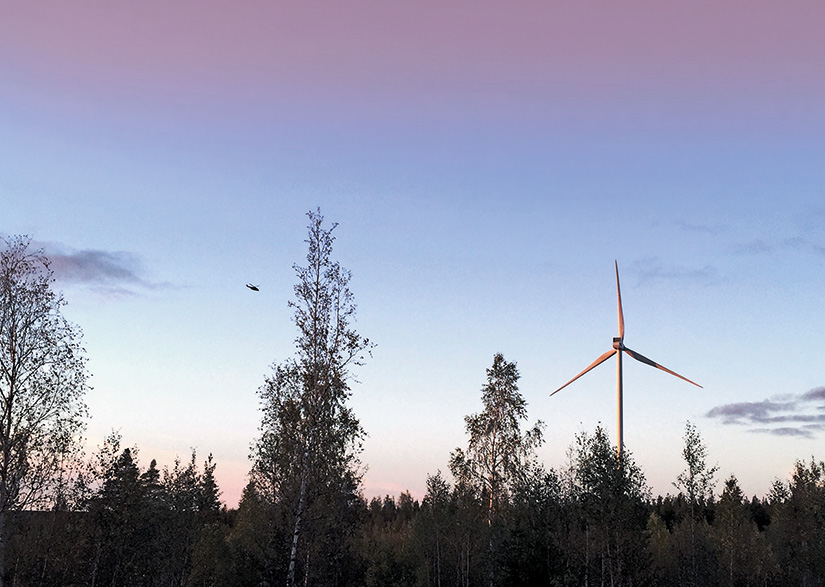Vestas Wind Systems has recently activated its on-demand aviation lights system in Finland. The system, called Obstacle Collision Avoidance System (OCAS), is installed at the Svalskulla wind farm in Närpes and was put in operation on May 2nd. This is the first system of its kind in Finland following an approval by Trafi in early April. It is developed to facilitate the acceptance of wind farms and to open up new investment opportunities – in particular for wind farms with tall towers.
The Finnish Wind Power Association has interviewed Erik Meum who is heading Vestas’ OCAS department about how the system works and its benefits.
Can you tell us what OCAS is?
– OCAS is a system designed to limit the time in which the aviation lights on wind turbines are turned on. Tall structures, including wind turbines, need to be equipped with aviation lights to warn aircrafts of their presence. These lights are turned on 24 hours a day, regardless of aircraft presence, providing unnecessary lighting. The experience is that these lights might be annoying to people living close to wind farms and especially for those living close to wind turbines taller than 150 metres for tip height, as they require high intensity white lights. With OCAS, the aviation lights will only be activated when there is an actual need for it, in other words, when an aircraft is approaching. At all other times the lights are turned off, leaving the turbines dark for the neighbours.
Can you elobarate on how the system works?
– The system enables an intelligent surveillance of aircrafts in the proximity of wind farms. We install radar units on the tower of selected turbines in the wind farm, which then tracks the speed, direction, and altitude of aircrafts in the vicinity of the wind farm. If an aircraft is approaching, OCAS will turn on all aviation lights on the turbines in the wind farm and keep them on until the aircraft has safely passed. It is important to note that the system does not require installation of any equipment in the actual aircrafts.
OCAS was approved by Finnish Trafi in April, what does this mean for Finnish wind farm owners?
– What we have seen from other markets is that the system facilitates local acceptance for wind farms with higher tip heights. High tip heights can often improve the business case, as it has the potential of increasing the annual energy production with several percentages. So, in areas where the aviation lights on wind turbines are of concern to the local community, OCAS may actually open up new commercial opportunities. We have also seen that permitting processes goes quicker, due to less local resistance. Hence, the approval of OCAS benefits both the local communities and wind farm developers.
Is the system in use in other countries already and what are your expreriences there?
– OCAS is already approved and in operation on several sites with good results in Sweden, Norway, and Canada with approvals on the way in the US, Germany and Switzerland. We have seen that once the system gets approved, the interest for this solution rapidly increases. Many of the wind farm developers see the benefits from it. Furthermore, we have experienced that people living nearby a wind farm equipped with OCAS pay a lot of attention to its functionality. If for instance the internal network in the wind farm is down due to maintenance, and the aviation lights are activated, they are very quick to contact us and ask about why the lights are flashing. To me this shows that they appreciate the on-demand functionality provided by OCAS.
Is it guaranteed to be safe?
– Yes, OCAS has a proven track record from operation for more than 10 years. The system has previously been thoroughly tested in Sweden, Norway, and Finland including high-speed tests with military aircrafts. Also, in the unlikely event that the system fails, all aviation lights are automatically turned on. OCAS includes continuous radar surveillance, aviation light control, and monitoring services to keep full track of the system status at all times.
How expensive is it?
– The cost depends on the number of radars required to cover the surrounding of the wind farm. This in turn is determined by the site layout, its complexity, and of course the size of the wind farm. OCAS is a fully integrated solution on Vestas turbines, which minimises both CAPEX and OPEX for our customers.
Can the system be installed on already operating wind farms or is it only for new ones?
– The OCAS system can indeed be retrofitted and installed on already operating wind turbines. Because the system is already integrated into Vestas turbines, an installation would require no more than a day of down-time for each wind turbine.
*******
OCAS (Obstacle Collision Avoidance System) on Vestaksen kehittämä järjestelmä, jonka avulla tuulivoimaloiden lentoestevalot voidaan pitää suurimman osan ajasta poissa päältä. Järjestelmän keskeinen osa ovat tutkayksiköt, jotka lentokoneen tai muun lentoaluksen havaitessaan ohjaavat voimalan valot syttymään automaattisesti siksi ajaksi, että lentokone on turvallisesti ohittanut voimalan. Järjestelmän avulla voidaan vähentää valoista lähiasukkaille mahdollisesti aiheutuvaa häiriötä.
Trafi on antanut hyväksyntänsä järjestelmän käyttämiseksi Närpiön Svalkullassa ensimmäisen kerran Suomessa. Järjestelmiä on aiemmin asennettu esimerkiksi Ruotsissa. OCASia on testattu laajasti, myös ilmavoimien nopeilla lentokoneilla. Mikäli järjestelmän toiminta estyy esimerkiksi puiston huoltotöiden vuoksi, palavat valot jatkuvasti automaattisesti. Järjestelmä voidaan jälkiasentaa Vestaksen voimaloihin.
